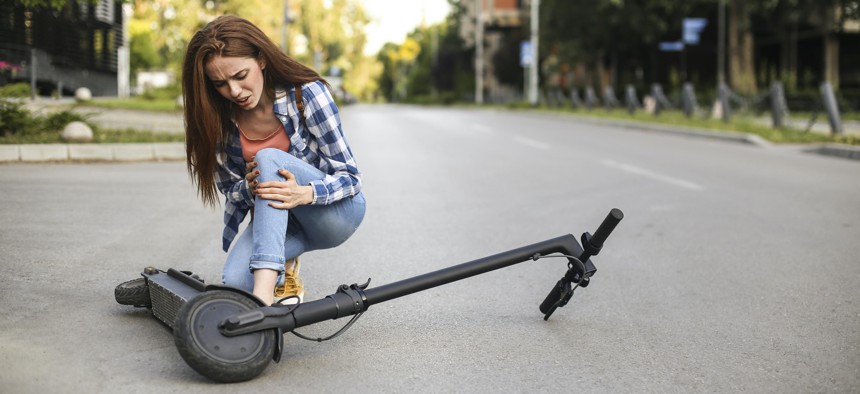80% of Fatal E-scooter Crashes Involve Cars – New Study Reveals Where and Why Most Collisions Occur

ISTOCK.COM/GoodLifeStudio
COMMENTARY | Electric scooters have become a popular way to get around since their introduction to U.S. cities about three years ago. But fatalities are mounting.
About 30 people in the United States have been killed riding electric scooters since 2018. Most – 80% – were hit by drivers of cars.
Publicly available e-scooters arrived to U.S. cities in 2017 as an energy-efficient and fun new way to get around town. By 2019, e-scooter rides had soared from zero to 88 million trips annually.
But putting e-scooter riders on the same roads as cars without good infrastructure or clear rules has been dangerous. Making streets safer will require urban policymakers, not to mention drivers, to understand where and why cars collide with these new vehicles.
The few empirical studies on e-scooter safety come from emergency departments in cities where e-scooters launched early, like Los Angeles and Austin. They meticulously describe which injuries occurred and which bones were broken in crashes – primarily wrists and minor head injuries – and document the location on the body of other injuries, like scrapes and sprains.
But they do not provide insight about how and why these injuries happened. My “micromobility” research team, which studies lightweight and low-speed vehicles like e-bikes and e-scooters, has now conducted an in-depth study on e-scooter traffic safety, in Nashville, Tennessee.
Our findings, published in April 2021 in the Journal of Safety Research, found that e-scooter crashes with cars follow different patterns than bicycle crashes – but both result from unsafe infrastructure for nonmotorized vehicles.
Where E-scooters and Cars Collide
Safety has been a persistent barrier for cities in encouraging residents to adopt greener, alternative modes of transportation. Nationally, two-thirds of the more than 1,000 bicycle fatalities in 2018 occurred when riders were struck by a vehicle driver.
To better understand how e-scooter collisions with cars compare, we scoured Nashville police reports of crashes between 2018 and 2020. E-scooters launched in Nashville in 2018.
In total, we identified 52 documented e-scooter crashes and 79 bicycle crashes, with one scooter rider fatality and no bicyclist fatalities.
About 80% of both bike and e-scooter crashes happened at intersections, and about 70% occurred in daylight. That was somewhat surprising. An influential 2019 study on e-scooter safety in Austin, Texas identified nighttime riding as riskiest.
Instead, our study points to riding on the sidewalk as the main risk on e-scooters.
Despite local rules prohibiting scooter-riding on sidewalks, more than 60% of crashes between cars and scooters happened when a sidewalk scooter rider and driver collided at either a driveway or crosswalk. The scooter was almost always coming from the car’s right, where drivers likely aren’t expecting moving vehicles to come off the sidewalk and into traffic.
Nashville cyclists mostly ride on the road, so they crash at driveways and crosswalks about as half as often. They are much more likely to be hit from behind, or when either the driver or bike rider turns across the other’s path on the roadway. This finding aligns with other studies on bicycle-car crash patterns.
Policy Implications
E-scooter and bicyclist crashes with cars aren’t as different as they may seem. They both reflect a lack of infrastructure designed for people who choose alternate modes of transportation.
In many cities, bicycle lanes end or zigzag suddenly across the road. Intersections leave riders stranded in a dangerous swarm of moving vehicles.
Connected bike lines combined with protected intersections that give riders – particularly novices – intuitive ways to cross and turn would make streets safer. Simply limiting right-turn-on-red also reduces collisions between drivers, pedestrians and cyclists, studies show.
E-scooter parking is a problem, too.
Currently, scooter-share companies like Lime require scooters to be parked on sidewalks, placing riders onto the sidewalk at the beginning and end of each trip. Providing on-street parking can induce adult riders of powered e-scooters onto the street, where they belong.
But only better infrastructure will keep them there.
So far, in Nashville as in other cities, the main tactics made to keep scooter riders off sidewalks are educational campaigns, in-app messages and sidewalk decals. Clearly, that’s not working – and it is leading to crashes.
Hit-and-runs
Alcohol is not a major factor in e-scooter crashes in Nashville. Only two of Nashville’s 52 scooter riders involved in crashes were reported as intoxicated. Drunk cyclists were similarly rare.
This finding contradicts early data from San Diego and Austin pointing to alcohol as a factor in e-scooter crashes.
Drunk drivers did not seem to be a major cause of car-scooter and car-bike collisions in Nashville, either. That said, we know the intoxication level of only the drivers who stuck around to speak with police.
Of 104 Nashville drivers involved in e-scooter or bike crashes, 27 of them fled the scene.
[Understand new developments in science, health and technology, each week. Subscribe to The Conversation’s science newsletter.]
![]()
This article is republished from The Conversation under a Creative Commons license. Read the original article.
Christopher R. Cherry is a professor of civil and environmental engineering at the University of Tennessee
NEXT STORY: Cities Battle Another Long-Lasting Covid Reminder: PPE Litter





